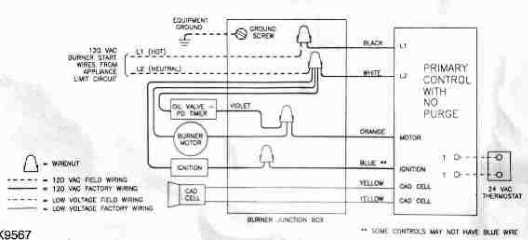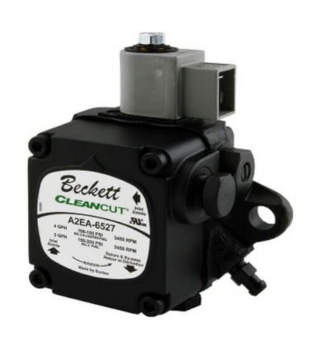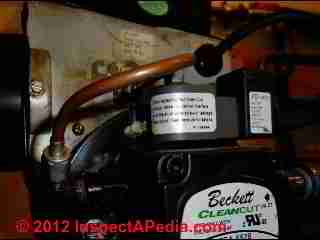 Oil Delay Solenoid Valves, Quick-Stop Valves, Oil Safety Valves
Oil Delay Solenoid Valves, Quick-Stop Valves, Oil Safety Valves
- POST a QUESTION or COMMENT about quick-stop valves, oil delay valves, & oil solenoid valves: definition, installation, uses, & troubleshooting
Oil quick stop valves or delay valves: this article describes solenoid operated quick stop valves used at oil burners. These oil safety valves, when they include a timer that delays valve opening at burner start-up, are also referred to as oil delay valves or oil delay solenoids.
Quick-stop valves and oil delay valves improve oil burner operation by eliminating the delivery of oil to the oil burner nozzle at low pressures. Low pressure oil delivery, which can be caused by air leaks or just slow burner start-up, causes dirty oil burner operation and can lead to loss of heat or dangerous oil burner puffbacks.
Here we explain how and why quick stop and oil delay valves are used, how they are installed, and how to diagnose problems with OSVs and quickstop or delay valves.
InspectAPedia tolerates no conflicts of interest. We have no relationship with advertisers, products, or services discussed at this website.
- Daniel Friedman, Publisher/Editor/Author - See WHO ARE WE?
Oil Delay Solenoid Valve or Quick-Stop Valve or Safety Valve Installations on Oil Burner Pumps / Fuel Units
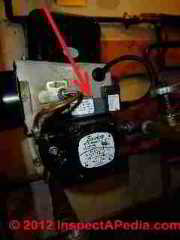 Here we explain two functions of an oil delay solenoid or quick-stop valve or solenoid safety valve.
Here we explain two functions of an oil delay solenoid or quick-stop valve or solenoid safety valve.
Oil heating technicians use at least four names for versions this device: an oil shut-off valve, an oil delay valve, a solenoid safety valve or a quick-stop valve. Some sources such as Sid Harvey also refer to this control as a "Magnetic Oil Burner Valve" (Honeywell).
[Click to enlarge any image]
Except for the presence or absence of providing a valve opening delay at oil burner start-up, these are all the same type of product and they have the same basic purposes:
- The quick stop valve assures a clean shutoff of oil flow to the oil burner nozzle when the oil burner is turned off, reducing the risk of a puffback explosion of un-burned low-pressure oil that might otherwise flow to the nozzle during burner shutdown.
The quick stop of oil flow is accomplished by using an electrically operated solenoid to open or shut the valve. - The quickstop valve [may depending on model] include a delay circuit that delays opening of the valve for a brief time [1-2 seconds or as much as 5 seconds depending on model] at the start of an oil burner on-cycle.This means we are delaying sending oil through to the nozzle and igniter.
Our term for this valve is Oil Delay Valve - the valve combines both a delay in opening at oil burner start-up and a quick stop function to shut down oil flow at burner stop.
This delay makes sure that the oil burner blower assembly is up to full speed, helping to assure very clean initial combustion and in some installations, helping establish draft before ignition. Both of those features act to reduce sooting and improve initial combustion of the heating oil being consumed. A thermistor inside the valve provides the desired start-up delay.
Shown in our photo above is R.W. Beckett's PD Timer part number 21887, a 120VAC 50/60 Hz control that provides a four second delay at burner start-up. The valve is rated for operating temperatures up to 150°F.
Sources of Internal Check Valve Troubles in the Oil Pump or Fuel Unit
In standard installations the fuel oil pumping unit sends high pressure heating oil through its outlet tube to an inlet fitting on the oil burner that in turn sends that high pressure oil to the oil burner nozzle where it is sprayed and ignited in the combustion chamber. When the oil burner tops, we want to quickly stop the flow of oil to the nozzle.
If we don't stop the oil flow quickly, heating oil at lower pressure continues to squirt, then dribble, out of the end of the nozzle where it will not benefit from complete combustion.
The result is an accumulation of un-burned heating oil in the combustion chamber - the cause of a "bang" or worse an oil burner puffback at the start of a subsequent oil burner "on" cycle.
Oil burner fuel units (oil pumps) already contain an internal check valve intended to quickly stop the flow of oil to the burner when the oil burner motor stops. But with age, or more likely with the passage of dirt and sludge from the oil tank, through the oil lines, through the oil filter, and finally sneaking past the internal filter screen found inside the fuel unit, that crud, or some of it, lands on the internal check valve seat where it can cause the valve to fail to seal quickly or completely.
How does an Oil Shut-off or Oil Delay Shut-off Valve Work & What Problems Does it Solve?
 An oil delay solenoid switch or valve, also popularly referred to by some service techs as a quick-stop valve, is an electrically operated valve installed on the oil line between the fuel unit and the oil burner nozzle assembly.
An oil delay solenoid switch or valve, also popularly referred to by some service techs as a quick-stop valve, is an electrically operated valve installed on the oil line between the fuel unit and the oil burner nozzle assembly.
Our photo (left) shows a new oil burner fuel unit installed on our older Beckett oil burner. It's worth reading the label on the fuel unit - it warns Use Only with Valve on Delay.
The oil delay valve, operated by an electrical solenoid switch, closes to immediately stop the flow of oil to the oil burner assembly the second that electrical power to the oil burner is shut off.
This quick-stop valve is a handy "fix" that we can add to an existing oil burner fuel unit if we think that its internal check valve is not working properly. (Few technicians would attempt to disassemble and clean the fuel unit to that level of detail, and an oil delay valve is less expensive than a whole new fuel unit.)
When the oil burner motor starts, the power circuit also powers the oil line solenoid valve. We call the device an oil-delay-valve because the valve includes a built-in time delay that allows the oil burner motor and blower assembly to spin for a brief time before the valve opens to permit oil to pass on to the burner nozzle. This delay, an added feature, helps establish draft and reduces sooting at the oil burner.
Oil Shut-Off Valves Integral with New Fuel Units
Interestingly, some fuel units now come from the manufacturer with an oil delay valve assembly already attached. The importance of a sharp clean cessation of oil flow makes this added feature desirable. We had asked our heating service company to install an oil delay valve on our oil burner to stop a startup "Bang" and soot problem that was chronic on our lab heating system.
Bob, Bottini's service tech, inspected more closely and found that the fuel unit had a small leak around its shaft. That leak sent oil into the oil burner assembly, crudding up the oil burner combustion air fan and adding to a dirty oil burner flame problem.
Since our oil burner fuel unit needed to be replaced anyway, it was more economical to install a new fuel unit that included as well an oil delay solenoid valve than it would have been to buy and install those parts separately.
Wiring the Oil Shut-off or Oil Delay Valve
Wiring the oil delay solenoid: for most models, the solenoid valve's electrical wires are connected to the oil burner "run" circuit inside the primary control by connecting the solenoid control circuit wires to the oil burner motor leads - in this case, the nearby cad cell relay.
[Click to enlarge any image]
The standard oil burner solenoid valve cord set can be replaced with a PD timer kit such as the R.W. Beckett PD Timer #21887U that provides a precise 4-second delay between the oil burner motor start-up and the opening of a valve that admits oil from the fuel unit to the oil burner nozzle. You should follow the wiring diagram that will certainly come with the product that you purchase.
Above we provide an example wiring diagram for an oil delay valve time, from Beckett's 21887U PD Timer delay cord set.
How Long does an Oil Shut-off Valve Delay at Oil Burner Start-up
To be clear, we want a zero-second delay at oil burner shut-down, as we explained above. But we may want our solenoid operated shut-off valve to delay its open by a few seconds to allow the burner and blower assembly to get up to full speed, improving draft and combustion air flow to assure a very clean start-up when oil is released to the oil burner nozzle and igniter.
Suntec, a manufacturer of fuel units and delay valves describes a solenoid dumping pump used on their A-7400 fuel unit as including
With a dumping solenoid incorporated in the charge circuit, [so that] nozzle cut-off occurs quickly, while the blower is at nearly full speed. The solenoid itself contains a thermistor which provides an approximate delay of 2 seconds on start-up, ensuring nozzle cut-on at high blower speeds.
Solenoid operated shut-off valves are sold in both non-delay models (Such as Suntec R642NL) and delay models that provide a 1-2 second delay (Suntec R641DL) or a 3-5 second delay (Suntec R643LL) or even up to 15 seconds of delay to suit various application needs.
No Heat Call Traced to Open Quick Stop Valve or Oil Delay Valve Electrical Connector
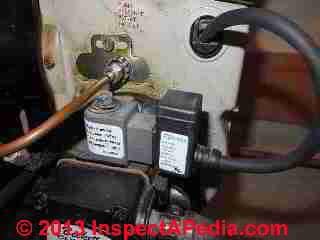 On a recent no-heat call we were embarrassed to learn from Bob, the service tech,
On a recent no-heat call we were embarrassed to learn from Bob, the service tech,
that the problem was most likely that somebody had accidentally knocked loose an electrical connector at the oil delay valve (aka "quick stop valve").
The valve in our photos is used by Beckett on some oil burner models (depending on fuel unit features) and is labeled PD Timer.
The connector may still appear to be in place but may have been pushed slightly back or askew.
The result is that on a call for heat the oil burner motor will run but the burner will never ignite.
Why?
Because the oil delay valve delays forever - without its own electrical connector it never opens.
The result is that the burner will shut off on reset due to a failure of the cad cell to see flame.
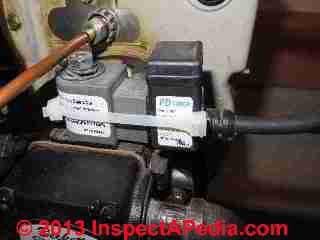 Our photos show this valve before and after we fixed the problem by securing the switch boot connector in place against another accidental knock-off.
Our photos show this valve before and after we fixed the problem by securing the switch boot connector in place against another accidental knock-off.
We tied the rubber boot (black rectangle at the right side of the valve itself) to the PD Timer oil delay valve body (gray in center of the photo) using plastic ties.
As Bob pointed out, this step to prevent the oil delay valve or PD Timer connector from being knocked loose again is ok as long as you're not foolish enough to wrap the plastic tie around the oil line (copper in our photo, above the PD Timer delay valve body).
The PD Timer is produced by RW Beckett, a manufacturer of the oil burner in our photos indicates that an alternative to the PD Time is to "Use 21844U Clean Cut Pump without PD Timer when primary control has a pre-time (valve on delay)."
We might wish that the manufacturer of the PDTimer had included a simple clip that would prevent the connecting wiring boot from being knocked off of the valve body.
Other than the loose-connector trouble leading to no-heat calls, this quick stop / oil delay valve has performed flawlessly on our test system since installation.
Other Heating Oil Piping & Flow Control Valves
Don't confuse oil safety valves, oil delay valves, or oil quick stop valves discussed in the article above with others listed among the recommended articles below at our CONTINUE READING link recommendations.
...
Reader Comments, Questions & Answers About The Article Above
Below you will find questions and answers previously posted on this page at its page bottom reader comment box.
Reader Q&A - also see RECOMMENDED ARTICLES & FAQs
On 2020-10-09 - by (mod) - Where would the solenoid go into the pump and how would it fasten?
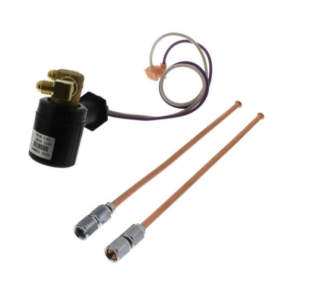 Tim
Tim
Thank you for the helpful question about retrofit oil quick stop valves or oil delay valves.
A retrofit oil delay valve typically mounts to an electrical wiring opening on the oil burner motor or on a close-by electrical box, using copper extensions to insert the solenoid control in the path of the high pressure oil line.
Shown here is a Beckett oil delay valve or "quickstop valve" with its accessory parts; in this form the valve typically mounts at an electrical wiring opening on an electrical box or on the oil burner motor.
The two copper tubes are adapters that allow the oil delay/quickstop valve to interrupt or control flow of oil through the high pressure line between the fuel unit and the oil burner nozzle.
The electrical connectors feed the timer or delay valve solenoid from the same circuit that powers the oil burner motor.
These valves are meant to be able to be installed to any oil burner as a retrofit product when needed, specifically because it's often on an older oil burner that its own internal stop valve has failed.
The valve is installed on the high pressure oil line between the oil burner's fuel unit (pump) and the nozzle line, and is mounted and secured by the technician at a variable location - whatever is convenient.
QuickStop Valve Installation Instructions
- PRECISION DELAY (PD) TIMER KIT #21887U INSTALLATION INSTRUCTIONS [PDF] courtesy of R.W. BECKETT CORPORATION P.O. Box 1289, Elyria, Ohio 44036 USA & R.W. BECKETT CANADA, LTD 430 Laird, Unit 3, Guelph, Ontario, N1G 3X7
The Beckett Cleancut fuel unit developed by Beckett and Sunstrand (a fuel unit manufacturer) is sold with the quickstop valve already mounted to the top of the fuel unit.
- BECKETT CLEANCUT FUEL UNIT INSTALLATION MANUAL [PDF] (Op. Cit.) for the unit shown below. This is a single stage oil burner pump or fuel unit A2EA-6527 from Beckett.
On 2020-10-09 by Tim
Despite the warning "Use Only with Valve on Delay.: the valve will work on shut down and the pump will work on start up except for not as clean start due to no delay?
I'm not clear if a valve is avalable to add on to older units. Where would the solenoid go into the pump and how would it fasten? Maybe I should just get the newer one and also the PD delay.
This site is a wonderful help to many people.
On 2020-07-24 by Jim
My heater stopped working . I have changed the motor and the pump, but now it won’t purge. It goes right to fire even without power to the colinoid ?
On 2016-04-11 - by (mod) -
Jamal:
Take a look at the flame pattern and behaviour when the burner is running. Typically if there is a nozzle adapter leak you'll see fire spraying about in odd directions at the joint from noxzzle to nozzle adapter.
Look at the turbulator.
Replace the nozzles.
Be sure that size (3 GPH) is within the boiler's rated firing range.
Check the draft too.
On 2016-04-08 by Jamal
Easier said than done! There is no technician in Aruba. We are busy getting a pressure meter to check the pump pressure.
And we are checking the factory according to factory manual. Diesel is used with the supplied nozzle of 3GPH at 12 bar. We are checking the air damper and combustion head distance. Will keep you posted. Thank for your kind help.
On 2016-04-08 - by (mod) -
Watch out: you are describing an unsafe situation risking a puffback explosion.
The problem can be in any of several places: nozzle defects, nozzle adapter damage, wrong nozzle, wrong fuel unit output pressure, etc. You need an onsite service diagnosis asap. Keep me poste.
On 2016-04-08 by Jamal
Hi, We have 4 Riello burners. We discovered that there is a lot of oil passing thru the nozzle which are not burned. So, you have spray of oil partially combusted. Any idea why this is happening?
On 2015-03-10 - by (mod) -
F.
I'm not sure precisely what you mean by "steadily building pressure" - the delay valves we have used can include a longer delay than you cite.
The purpose is to allow the burner's blower to build a good draft before ignition, assuring cleaner starts. The fuel unit builds up to its operating pressure very quickly - I haven't seen a time vs. pressure chart but I expect it's up to full set-pressure well before the valve opens.
Depending on the fuel unit / oil burner model, this is typically anywhere (as set) between 100 psi and 200 psi.
On 2015-03-10 by Mr Froman
"The quickstop valve [may depending on model] include a delay circuit that delays opening of the valve for a brief time [1-2 seconds or as much as 5 seconds depending on model] at the start of an oil burner on-cycle.This means we are delaying sending oil through to the nozzle and igniter."
Does this mean that the pump is steadily building pressure for the period of time it runs before ignition?
On 2014-11-24 - by (mod) -
Austin the delay vales I've seen are not field repairable. If the leak was truly from the valve itself and not from an oil line connection the valve should be replaced.
On 2014-11-24 1 by Austin
I have a leak from the solenoid delay and can not find a diagram to tell me if there is a gasket on the devise and/or how to correct the leak.
Will anyone help?
On 2012-10-30 by Mike
Can a dirty quick stop valve cause loss of prime?
...
Continue reading at OIL SUPPLY LINE SAFETY VALVES, OSVs, or select a topic from the closely-related articles below, or see the complete ARTICLE INDEX.
Or see these
Recommended articles
- FIRE SAFETY CONTROLS - on heating equipment
- OIL SUPPLY & RETURN LINE CONTROLS & VALVES - topic home
- OIL BURNER DELAY VALVE
- OIL BURNERS - home
- OIL SUPPLY LINE CHECK VALVES
- OIL SUPPLY & RETURN LINE DE-AERATORS Tigerloop™
- OIL LINE QUICK STOP VALVES
- OIL SUPPLY LINE SAFETY VALVES, OSVs
- OIL SUPPLY LINE VACUUM-ACTIVATED OSVs & PRVs
Suggested citation for this web page
at InspectApedia.com - online encyclopedia of building & environmental inspection, testing, diagnosis, repair, & problem prevention advice.
Or see this
INDEX to RELATED ARTICLES: ARTICLE INDEX to HEATING OIL, OIL BURNERS, OIL FIRED HEATERS, OIL TANKS
Or use the SEARCH BOX found below to Ask a Question or Search InspectApedia
Ask a Question or Search InspectApedia
Try the search box just below, or if you prefer, post a question or comment in the Comments box below and we will respond promptly.
Search the InspectApedia website
Note: appearance of your Comment below may be delayed: if your comment contains an image, photograph, web link, or text that looks to the software as if it might be a web link, your posting will appear after it has been approved by a moderator. Apologies for the delay.
Only one image can be added per comment but you can post as many comments, and therefore images, as you like.
You will not receive a notification when a response to your question has been posted.
Please bookmark this page to make it easy for you to check back for our response.
IF above you see "Comment Form is loading comments..." then COMMENT BOX - countable.ca / bawkbox.com IS NOT WORKING.
In any case you are welcome to send an email directly to us at InspectApedia.com at editor@inspectApedia.com
We'll reply to you directly. Please help us help you by noting, in your email, the URL of the InspectApedia page where you wanted to comment.
Citations & References
In addition to any citations in the article above, a full list is available on request.
- In addition to citations & references found in this article, see the research citations given at the end of the related articles found at our suggested
CONTINUE READING or RECOMMENDED ARTICLES.
- Carson, Dunlop & Associates Ltd., 120 Carlton Street Suite 407, Toronto ON M5A 4K2. Tel: (416) 964-9415 1-800-268-7070 Email: info@carsondunlop.com. Alan Carson is a past president of ASHI, the American Society of Home Inspectors.
Thanks to Alan Carson and Bob Dunlop, for permission for InspectAPedia to use text excerpts from The HOME REFERENCE BOOK - the Encyclopedia of Homes and to use illustrations from The ILLUSTRATED HOME .
Carson Dunlop Associates provides extensive home inspection education and report writing material. In gratitude we provide links to tsome Carson Dunlop Associates products and services.


